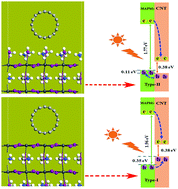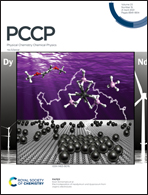Termination dependence and electric field modification of band alignment in a CNT/CH3NH3PbI3 heterojunction
Abstract
Carbon nanotube (CNT) and perovskite composite materials possessing the combined advantages of CNTs and perovskites have drawn substantial attention due to their promising applications in photovoltaic and optoelectronic devices. Understanding the band alignment of heterojunctions is crucial for further performance improvement. Here, we systematically investigated the interfacial electronic structure and optical absorption of a semiconducting CNT/CH3NH3PbI3 heterojunction via density functional theory calculations. It was found that the CNT/PbI2-terminated CH3NH3PbI3 (001) surface heterojunction is a type-I band alignment, while the CNT/CH3NH3I-terminated CH3NH3PbI3 (001) surface heterojunction is a type-II band alignment, suggesting the different charge carrier transfer processes as well as termination dependence of band alignment in the CNT/CH3NH3PbI3 heterojunction. Further investigation indicated that applying electric fields can modify the band alignment type in the CNT/CH3NH3PbI3 heterojunction. Our results provide the first insight into the interfacial electronic structure of the CNT/CH3NH3PbI3 heterojunction, which may give a new route for designing optoelectronic devices.



 Please wait while we load your content...
Please wait while we load your content...